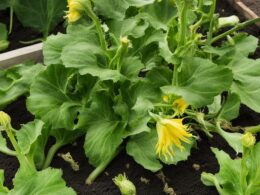If you’ve ever come across a magnificent shade tree with striking camouflage bark and large, lobed leaves, you are most likely looking at a sycamore tree. These grand and stately trees are known for their distinct features that set them apart from other species.
The most notable characteristic of a sycamore tree is its unique bark. The bark of a sycamore tree is mottled with a pattern of brown, green, and white colors. It peels off in patches, revealing the inner bark and adding to the tree’s distinctive appearance.
The leaves of a sycamore tree are fairly large, typically with three to five lobes and saw-toothed edges. They have fuzzy undersides and their veins radiate from a single point. These features make them easily recognizable, even from a distance.
Sycamore trees come in several species, including the American Sycamore Tree, California Sycamore Tree, Arizona Sycamore Tree, and Old World Sycamore Tree. Regardless of the species, sycamores are known to grow to impressive heights of 75 to 100 feet, with a spread of 50 to 70 feet.
These trees prefer full to partial sun and have a moderate to rapid growth rate of approximately 2 feet per year. It’s important to note that sycamores are susceptible to diseases like anthracnose and pests like lace bugs, requiring proper care and maintenance to thrive.
The distinct features of sycamore trees extend beyond their bark and leaves. They also produce unique flowers and fruit. The small, yellow-green flowers grow in clusters, while the fruit consists of many tiny seed-like fruits called achenes. These lightweight fruits can float on water, aiding in the dispersal of sycamore tree seeds.
Whether you’re admiring their beauty, seeking shade, or marveling at their ecological significance, sycamore trees are truly a sight to behold. Stay tuned to learn more about how to identify these magnificent trees in our following section.
How to Identify a Sycamore Tree
Sycamore trees can be easily identified by their distinctive features.
The bark of a sycamore tree is one of its most recognizable characteristics. It peels off in large, flaky patches, revealing a mottled pattern of brown, green, and white colors.
The leaves of the sycamore tree are large, typically with three to five lobes and saw-toothed edges. They have fuzzy undersides and veins that radiate from a single point.
Sycamore trees flower in the spring, producing small, yellow-green flowers that grow in clusters. These flowers eventually give way to fruit, which are woody balls containing many tiny seed-like fruits called achenes. These achenes are light and can float on water.
In the autumn, the leaves of the sycamore tree turn brown before falling off for the winter.
These distinctive features make it easy to identify a sycamore tree in any season.
Are Sycamore Trees Known for Their Seed Pods?
Yes, sycamore trees are known for their large and distinctive varieties of seed pods. These seed pods contain tiny seeds that are dispersed by the wind, giving them their reputation for being a prominent feature of sycamore trees.
The Significance and Uses of Sycamore Trees
Sycamore trees hold a significant place in folklore and mythology, with a rich history that dates back to ancient civilizations. In ancient Egyptian beliefs, sycamore trees were revered as symbols of protection and were thought to guard against evil spirits. The ancient Greeks and Persians considered them the most handsome trees, appreciating their majestic presence and distinctive beauty.
Throughout history, sycamore trees have been mentioned in religious texts, including the Bible, further cementing their cultural significance and spiritual symbolism. They have been associated with wisdom, strength, and the eternal cycle of life and rebirth.
In addition to their folklore significance, sycamore trees have practical uses. The bark of the sycamore tree has been utilized for its medicinal qualities. In homeopathic remedies, the bark has been used for its disinfectant properties, making it an effective natural remedy.
The wood of the sycamore tree has been highly valued for its versatility and durability. It has been used in various applications, including the construction of canoes, furniture, and the crafting of musical instruments like violins. The resilience of sycamore wood makes it a sought-after material in these industries, contributing to its continued use throughout history.









